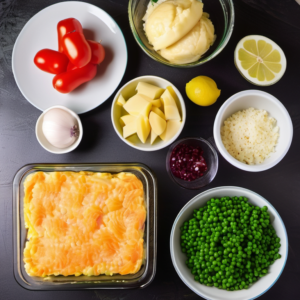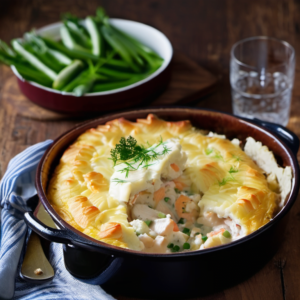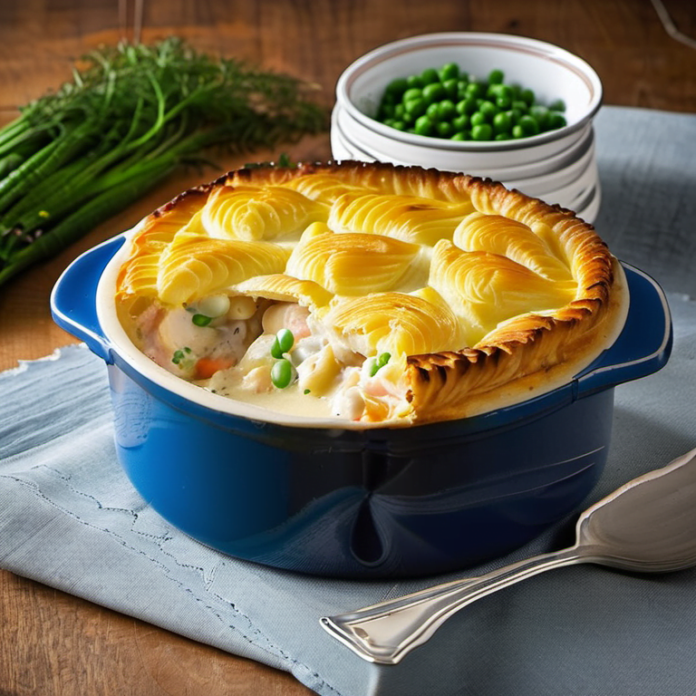How to Make the Perfect Classic Comfort Food, Fish Pie?
Why Fish Pie is a Classic Comfort Food
Fish pie is a classic comfort food that has been enjoyed for centuries. Its origins can be traced back to the British Isles, where it was a popular dish among fishermen and their families. The pie is typically made with a creamy filling of fish and vegetables, topped with a buttery crust. It is a hearty and satisfying meal that warms the soul.
Fish pie became popular as a comfort food because it was an affordable and nutritious option for families. Fish was readily available in coastal areas, and the pie allowed for the use of leftover fish or cheaper cuts. The addition of vegetables provided additional nutrients and flavors. The creamy sauce and buttery crust added richness and indulgence to the dish.
Today, fish pie remains a beloved comfort food around the world. Its simplicity and versatility make it a favorite among home cooks. It can be customized with different types of fish, vegetables, and seasonings to suit individual tastes. Whether enjoyed on a cold winter’s night or as a special Sunday dinner, fish pie continues to bring comfort and joy to those who indulge in it.
Choosing the Right Fish for Your Pie
When making fish pie, it is important to choose the right type of fish to ensure a delicious and flavorful result. While there are no hard-and-fast rules, certain types of fish work better in pies than others.
White fish such as cod, haddock, or pollock are commonly used in fish pies due to their mild flavor and flaky texture. These types of fish hold their shape well when cooked and pair nicely with the creamy filling.
Salmon is another popular choice for fish pie, as it adds a rich and buttery flavor to the dish. Smoked salmon can also be used for added depth of flavor.
When choosing fish for your pie, you have the option of using fresh or frozen fish. Fresh fish is always preferred, as it tends to have a better texture and flavor. However, frozen fish can be a convenient option, especially if fresh fish is not readily available. Just be sure to thaw the fish properly before using it in the pie.
Sustainability is also an important consideration when choosing fish for your pie. Overfishing and unsustainable fishing practices have led to the decline of many fish populations. It is important to choose fish that are caught or farmed in a sustainable manner. Look for certifications such as the Marine Stewardship Council (MSC) or the Aquaculture Stewardship Council (ASC) to ensure that the fish you are using is sourced responsibly.
Preparing Your Fish for the Pie
Before adding the fish to your pie, it is important to clean and fillet it properly. This ensures that any bones or scales are removed and that the fish is ready to be cooked.
To clean the fish, rinse it under cold water and pat it dry with paper towels. Use a sharp knife to remove any scales by scraping them off in a downward motion. Be sure to remove any remaining scales from the skin.
To fillet the fish, start by making a small incision behind the gills and along the backbone. Use a sharp knife to carefully cut along the backbone, separating the fillet from the rest of the fish. Repeat on the other side of the fish. Once both fillets are removed, use tweezers or pliers to remove any remaining bones.
There are several cooking methods that can be used for fish pie, including poaching, baking, or frying. Poaching is a popular method as it allows the fish to cook gently and retain its moisture. To poach the fish, place it in a pan with enough liquid (such as milk or stock) to cover it. Bring the liquid to a simmer and cook until the fish is opaque and flakes easily with a fork.
Baking is another common method for cooking fish pie. To bake the fish, place it in a preheated oven and cook until it is opaque and flakes easily. This method allows for a slightly drier texture and a golden crust on top.
Regardless of the cooking method you choose, be sure to season the fish with salt and pepper to enhance its flavor. You can also add additional seasonings such as herbs, spices, or lemon juice to suit your taste.
Making the Perfect Pie Crust: Tips and Tricks
The crust is an important component of fish pie, as it provides a delicious and buttery contrast to the creamy filling. Making the perfect pie crust requires a few key ingredients and techniques.

For the crust, you will need flour, butter, salt, and cold water. The flour provides structure, while the butter adds richness and flavor. The salt enhances the taste of the crust, and the cold water helps bind the ingredients together.
To make the crust, start by combining the flour and salt in a large bowl. Cut the cold butter into small cubes and add it to the flour mixture. Use your fingertips or a pastry cutter to rub the butter into the flour until it resembles coarse crumbs.
Next, gradually add cold water to the mixture, stirring with a fork until a dough forms. Be careful not to overmix, as this can result in a tough crust. Once the dough comes together, shape it into a ball and wrap it in plastic wrap. Refrigerate for at least 30 minutes to allow the dough to rest and firm up.
When ready to use, roll out the dough on a lightly floured surface until it is large enough to cover your pie dish. Gently transfer the rolled-out dough to the dish, pressing it into the corners and edges. Trim any excess dough from the edges and crimp them with your fingers or a fork for a decorative finish.
To ensure a crisp and flaky crust, it is recommended to pre-bake the crust before adding the filling. This helps prevent the crust from becoming soggy. To pre-bake the crust, line it with parchment paper and fill it with pie weights or dried beans. Bake in a preheated oven for about 10 minutes, then remove the weights and continue baking until the crust is golden brown.
Preparing the Filling: Vegetables, Herbs, and Sauces
The filling of a fish pie typically consists of a combination of fish, vegetables, herbs, and sauces. These ingredients add flavor, texture, and color to the dish.
Common vegetables used in fish pie include carrots, peas, leeks, and onions. These vegetables add sweetness and crunch to the filling. They can be cooked beforehand or added raw to the pie, depending on personal preference.
Herbs and spices are also important for adding depth of flavor to the filling. Popular choices include parsley, dill, thyme, and bay leaves. These herbs can be added to the cooking liquid when poaching the fish or sprinkled over the filling before baking.
Sauces are another key component of the filling. A creamy white sauce is traditional for fish pie and can be made by combining butter, flour, milk, and seasonings. This sauce adds richness and creaminess to the dish. Alternatively, you can use a tomato-based sauce or a combination of both for added flavor.
When preparing the filling, it is important to cook any raw vegetables beforehand to ensure they are tender when the pie is baked. This can be done by sautéing them in butter or oil until they are soft and slightly caramelized.
Layering Your Fish and Filling for the Perfect Pie
Layering the fish and filling it properly is key to creating a balanced and flavorful fish pie. The goal is to distribute the ingredients evenly throughout the pie, ensuring that each bite is filled with a combination of fish, vegetables, and sauce.
Start by spreading a thin layer of sauce on the bottom of the pie dish. This helps prevent the fish from sticking to the dish and adds moisture to the filling. Next, layer the fish on top of the sauce, making sure to cover the entire surface of the dish. If using different types of fish, alternate them to create a variety of flavors and textures.
Once the fish is layered, add the cooked vegetables on top. Spread them evenly over the fish, making sure to cover any gaps. This helps create a cohesive filling and ensures that each bite contains a combination of fish and vegetables.
Finally, pour the remaining sauce over the filling, making sure it covers all the ingredients. This helps bind everything together and adds creaminess to the pie. Use a spoon or spatula to gently spread the sauce and smooth out any lumps or bumps.
Baking Your Fish Pie: Temperature and Time
Baking your fish pie at the right temperature and for the correct amount of time is crucial to achieving a perfectly cooked dish. The goal is to cook the fish until it is opaque and flakes easily, while ensuring that the crust is golden brown and crispy.
Preheat your oven to 375°F (190°C) before baking your fish pie. This allows for even heat distribution and ensures that the pie cooks properly.
The baking time will vary depending on the size and thickness of your pie. As a general rule, bake the pie for about 30-40 minutes, or until the crust is golden brown and the filling is bubbling around the edges. To check if the fish is cooked, insert a fork into the center of the pie and gently twist it. If the fish flakes easily, it is done.
It is important to keep an eye on your pie while it is baking to prevent it from overcooking or burning. If the crust starts to brown too quickly, cover it loosely with aluminum foil to prevent further browning.

Serving Suggestions: Side Dishes and Garnishes
Fish pie is a complete meal on its own, but it can be served with a variety of side dishes to enhance the dining experience. These side dishes provide additional flavors and textures that complement the pie.
A simple green salad is a popular choice to serve alongside fish pie. The freshness and crunch of the salad help balance out the richness of the pie. You can use a mix of lettuce, cucumber, cherry tomatoes, and radishes, dressed with a light vinaigrette.
Steamed or roasted vegetables are another great option. Broccoli, cauliflower, and carrots are particularly delicious when served with fish pie. Simply steam or roast the vegetables until they are tender, then season with salt, pepper, and a drizzle of olive oil.
Mashed potatoes are a classic accompaniment to fish pie. The creamy and buttery texture of the mashed potatoes pairs perfectly with the rich filling. You can also add grated cheese or chopped herbs to the mashed potatoes for added flavor.
Garnishes can also be used to add visual appeal to your fish pie. Fresh herbs such as parsley or dill can be sprinkled over the top for a pop of color. Lemon wedges can be served on the side for squeezing over the pie before eating. Crispy breadcrumbs or grated cheese can be sprinkled over the top for added texture.
Variations on the Classic Fish Pie Recipe
While the classic fish pie recipe is delicious on its own, there are many variations that you can try to add variety and excitement to your meals.
Instead of using white fish, you can experiment with different types of fish such as trout, mackerel, or sea bass. These fish have distinct flavors that can add complexity to the dish.
You can also try alternative fillings and sauces to change up the flavor profile of your fish pie. For example, you can add cooked shrimp or crab meat to the filling for a seafood twist. You can also use a curry sauce or a tomato-based sauce instead of the traditional white sauce.
For a creative twist, you can experiment with different crust options. Instead of a traditional pastry crust, you can use mashed potatoes or sweet potatoes as a topping. This adds a unique and flavorful element to the dish.
Plant-Based Foods
Conclusion: Enjoying Your Perfect Fish Pie
Fish pie is a classic comfort food that has stood the test of time. Its rich and creamy filling, paired with a buttery crust, makes it a satisfying and indulgent meal. By choosing the right fish, preparing it properly, and layering it with flavorful fillings, you can create a fish pie that is perfect for any occasion.
Whether enjoyed on a cozy night in or served as a special Sunday dinner, fish pie is sure to bring comfort and joy to those who indulge in it. So gather your ingredients, roll up your sleeves, and get ready to create the perfect fish pie in your own kitchen.
Berry Global Group Boosts Film Recycling Capacity

